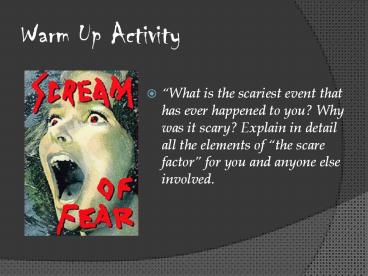Warm Up Activity - PowerPoint PPT Presentation
1 / 19
Title:
Warm Up Activity
Description:
... by Horace Walpole Gothic Edgar Allan Poe Considered to be the father of the horror genre, writing during the first half of the 19th century Was one of the ... – PowerPoint PPT presentation
Number of Views:101
Avg rating:3.0/5.0
Title: Warm Up Activity
1
Warm Up Activity
- What is the scariest event that has ever
happened to you? Why was it scary? Explain in
detail all the elements of the scare factor for
you and anyone else involved.
2
Horror Verses Gothic
3
Gothic, Horror...Potato, Patato?
- While most people use Gothic and horror
interchangeably, they actually are two separate
genres - Gothic is more like horror's predecessor
- Gothic was not exactly mainstream literature of
the time, but like any genre it held tight to
some base elements - Huge, dark mansions or castles
- Ghosts
- Damp cellars or dungeons
- Still mostly stayed away from socially
inappropriate behaviordrew a very clear line
between right and wrong - Usually had happy endings despite dark themes
- First recognized Gothic novel was The Castle of
Otranto (1764) by Horace Walpole
4
Gothic
5
Edgar Allan Poe
- Considered to be the father of the horror genre,
writing during the first half of the 19th century - Was one of the first to advocate for distinctly
horror elements as subject matterdisease, death,
and the disgusting - His literary theory was what really pulled him
from Gothic to horror though - He truly disliked didacticism that Gothic seemed
to hold dear and preferred to keep the meaning of
the work as an undercurrent
6
Horror Disease
7
Horror!
- As mentioned earlier, horror as a genre may pull
some ideas from Gothic but is still separate from
its predecessor - Elements of Horror
- Explores the dark, malevolent side of humanity
- Mood is menacing and foreboding in order to
receive an immediate response from the reader - Style is generally plain
- Setting (especially if only happening in one
locale) tends to be described in great detail - Main characters, even though the audience can
partially relate in some way, tend to be haunted
and estranged individuals - The key ingredient is to provoke terror through
the monstrous
8
Horror Monstrous
9
Horror!
- There are two main plot styles for horror
stories - Complex discovery plot (usually embracing the
theme of knowledge of or discovery of the
unknown)? - Onset of a horrific event-gt discovery of its
cause-gt confirmation of its cause-gt confrontation
that leads to victory or defeat - Over-reacher plot (usually embracing the theme of
some knowledge is better left undiscovered)? - Preparation for the experiment-gt experiment is
conducted-gt confrontation - These plots can be mixed to create countless
variations!
10
Horror Discover Leads to Defeat
11
Lets Review Prior Knowledge
12
Dramatic Irony
- In dramatic irony the reader or audience knows a
truth that the characters do not. - Have you ever seen a horror movie that has a
killer on the loose? You, and the rest of the
audience, know that the teenagers should not go
walking in the woods late at night, but they
think a midnight stroll would be romantic.
Needless to say, the teens become the next
victims. - Give three examples of dramatic irony that you
have seen or read.
13
- Authors of scary stories often use setting
- and word choice to create a disturbing
- mood or atmosphere.
14
Mood
- Definition Mood is the feeling that a work of
literature evokes. - As you read a short story - ask yourself
- "What feeling is the author creating through her
choice of words?"
15
Suspense
- Suspense The growing of excitement felt by an
audience or individual while awaiting the climax
of a movie, book, play, etc. due mainly to its
concern for the welfare of a character they
sympathize with or the anticipation of a violent
act. - As a group, discuss and give three examples of
suspense in literature or film.
16
Conflict Internal fighting within yourself.
Trying to make decisions. External
fighting with an outside source.
Climax
Falling Action
Rising Action
Introduction
Resolution
17
Monstrous Monsters
Both must be present to create a monster of HORROR
- There are two keys to the creation of a monster
- Threatening
- Must threaten physically, spiritually, socially,
psychologically, morallyor all of the above - This aspect stirs the emotion of FEAR
- Impure
- Must violate the generally accepted schemes of
cultural categorization - This aspect embraces the emotion of DISGUST
18
Monstrous Monsters
- Impure aspects of a monster what does it mean
to go against norms of cultural categorization? - Categorically ambiguous (amphibians existing both
in and out of water)? - Incomplete representatives of their classes
(things with missing parts, rotting things, or
things not fully formed)? - Formless things (blobs, fog, or dirt)?
19
The End
- or is it?































